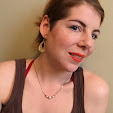If you want to you can read about my childhood in part one here
Me at 15
When I changed school at age 15, to go to Gymnasium(1.) and choose to study Art I became part of a small group consisting of mainly other female students of the more bohemic variant. There was absolutley no bullying, and body based comments were kept at a minimum. We did nude studies and our main teacher, an older man, described all kinds of bodies as being both natural and beautiful. We studied the treatment of the female form in art through the decades and learnt about how fashion went from celebrating the fat, to shunning it. That the way we view fat is dictated by the time we live in.
I even posed nude myself in my final year, after I had turned 18.
I remember having lunch with my classmates and when I had to squeeze between two chairs, I made a comment about my weight. The thin (to me) classmate replied in a most natural manner that I wasn't fat, I merely had curves.
I started taking pride in my rounded buttocks, my wide hips and my "curves". I called myself hourglass-shaped, a most sought after body type in many kinds of art.

Me at 17
I do, off course, have body hating memories too! I was a teen, after all. Two things, the trouble with finding pant that fit my wide hips and round ass, catching a glimpse of stretch marks in a changing rooms mirror. Seeing the flab of my stomach and hating, hating, hating it. Lying in bed, voving to never ever eat again or to doing the hula hoop a 100 times a day. The other time, having troubles with boys and musing to my older brother that maybe I should put on 20 kilos and take my refuge in that. His retort?
Many men like larger women.
There was that, and the fact I hated exercise. I hated the idea of it, because of how I had been bullied, and ridiculed in primary school and being extra vulnerable at physical ed when I was forced by the teacher to do thing I failed horribly at, often with a leering crowd staring at me from the sidelines. I _knew_ I sucked at it. Never that I could run with my asthma and my weak ankles, hit a ball with my bad eyesight or do anything scary. (I did like rugby though, got all my aggressions out, but we rarely had that.)
A year after I finished Gymnasiet I moved away to Stockholm to be with friends I met of the Internet and get a job. In contrast to the small village I grew up in Stockholm had working public transportations. Instead of biking and walking everywhere, there was always a bus stop not more than five minutes away no matter where I was. I also stopped eating any kind of dairy, now that I had absolute control over my own diet, and so no longer battling the effects of lactose intolerance I quickly outgrew my clothes. All of them.
Eating a lot of fast food, living with a very thin friend who made me tasty dinners while I stressed and worked nights every other week and got up super early every other week also changed my body.
I remember buying those new clothes, and once complaining to my mother who was visiting that my "new" jeans didn't fit either. But I don't remember feeling fat. I was loving my life and whether I was fat was never an issue. It was irritating that my clothes size was beyond the "normal" sizes in H&M, but I was to thin to wear the so called "plus" sizes.
I have scrap of paper with the year and my weight jotted down. It's the same as my current weight, one year post partum.

Me at 21. I used to call this my fat picture.
I do however remember having weak arms. Being slow and feeling sluggish. Having others carry my stuff. Wheezing when running after buses or to catch the subway. Sweating or overheating when forced to climb hills. I'm at this weight now, but pants from this era do not fit, they are too loose. Part of why the pants are loose is because I lived six flight of stairs up, and my large buttocks were made up from a whole lot of muscle. But lower body strength was all I had, body wise. My asthma was bad (in part because I smoked).
I got fed up with Stockholm and moved across the country.
Having very little money I survived on pasta and canned fish. I walked all over town. It wasn't my plan to loose any weight but because of the life style change I did. I hit an all time low weight as an adult. But I'll leave this for the next part: Adulthood and motherhood.
This post was inspired by I'm giving up on diets and Fuck you, Fat shamers from Look Left of the Pleiades and was made possible at this time in my life by meeting Arwyn from Raising my Boychick on twitter, you can read her post On fat acceptance and fitness




